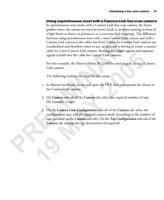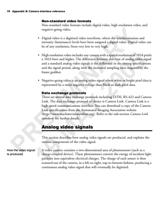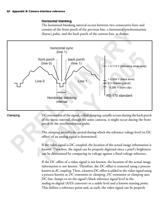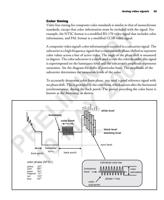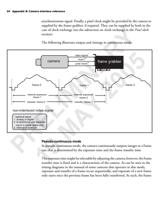
Camera modes of operation 97
Asynchronous reset mode
To grab a frame in asynchronous reset mode, either an external trigger signal is
provided to or an internal trigger is generated by the frame grabber. An internal
trigger can be periodic or aperiodic (controlled by software). The frame grabber,
in turn, triggers the asynchronously resettable camera to initiate exposure. The
trigger signal from the frame grabber to the camera is referred to as the exposure
signal. The camera is resynchronized on the exposure pulse. The delay from the
Y time the frame grabber is triggered to the time it sends an exposure signal is
programmable.
R There are three types of asynchronous reset modes used by cameras, as follows:
A 5 • Vertically asynchronously resettable: The vertical timings are reset on the
exposure pulse.
IN 0 • Vertically and horizontally asynchronously resettable: Both the vertical and
0 horizontal timings are reset on the exposure pulse.
IM 2 • Fully asynchronously resettable: The vertical and horizontal timings and the pixel
clock are reset on the exposure pulse.
❖ Refer to the timing diagrams found in your camera's manual to determine
L Y which of the three cases corresponds to your particular camera's asynchronous
reset mode.
E A In asynchronous reset mode, the exposure time can be adjusted on the camera
itself, or determined by the frame grabber’s exposure output. Some cameras will
ignore an exposure pulse that arrives before the current frame period is over, while
R M others will resynchronize on this new pulse, discarding all current information. In
general, to avoid losing information, the shortest time between external trigger
pulses should be greater than the sum of the exposure pulse width, the exposure
P time, and the frame transfer time.
19The signals used in asynchronous reset mode are an external trigger signal provided
to the frame grabber, an exposure signal supplied from the frame grabber to the
camera, the video output (analog or digital) and synchronization signals provided
to the frame grabber.





























































